|
A TOO BRIEF CONVERSATION WITH PETER RABE
by George Tuttle I first contacted Peter Rabe in the fall of 1989. In that letter, I told him about how I’d admired his fiction and asked if he’d be willing to let me interview him for Paperback Parade. He wrote back, agreeing to the interview, and said he was very flattered. We set up a time, and I called. We talked for about fifty minutes. The hardest part of preparing an interview for publication is typing up the transcripts. In this case, it took me almost three months. I would have finished sooner, but another project, work, and the holidays delayed its completion. But in January 1990, I had finished, and I sent the transcripts to Peter so that he could proofread and make changes. I also included some additional questions. Because I didn’t hear from Peter, I wrote him later that year, in May, and soon after, I received a letter from his companion of many years, Chris Nielsen. In the letter, Chris informed me that Peter had died on May 20 of lung cancer. The lung cancer was diagnosed in February.  I didn’t know until Chris’s letter that Peter had been ill. I couldn’t help but think about all the questions I could have asked during that interview, but didn’t. The chance to talk to Peter was truly an honor. He was one of the most gifted writers of paperback originals, writing some of the best crime fiction to come out of the 1950s. Reviewers compared him to Hammett, and today’s critics still discuss him as one of the greatest practitioners of the “roman noir.” Recently, author Ed Gorman wrote, “Along with John D. MacDonald and Charles Williams, [Rabe] was one of Gold Medal’s Holy Trinity. When he was rolling, crime fiction just didn’t get much better.” I’ll never forget our conversation. I wish it had been longer. How did you get into the writing business? By liking to write. I’d been writing for some time before I was published. It was an activity that I enjoyed. Gold Medal published your first three novels in rapid fashion, releasing them in successive months. Tell me about your beginnings at Gold Medal and the publication of Stop This Man!, Benny Muscles In, and A Shroud for Jesso. There came a point in my writing when I decided I wanted to write for a particular market, the paperback market. I was living in Maine at the time and was doing a lot of winter reading of paperbacks. I felt that some were more boring than need be, and having the time and inclination, I started to write for publication in this market. The first one was what they eventually called Stop This Man! I had a former friend from college who had become an agent. So I sent the manuscript, and he sent it to Gold Medal, and Gold Medal bought it. Actually the odd thing is that I had written and published something (From Here to Maternity) just before that novel, which had nothing to do with the paperback market or thrillers. So I enjoyed a two-punch turnover. First, with that first book, which was a book of humor with drawings, and then, in a very short period of time, a matter of six months, I sold this totally different thing, a crime novel. But that’s how it started. Then, liking the crime genre, I wrote several more. The next two ... what were they called. . . ? You see, none of the titles were mine. Because of that, I have difficulty associating them with the titles given to them by the publisher. 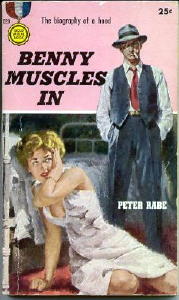 Yes, well, there was Benny Muscles In ... Benny Muscles In, for God sake, what a title [laughter], and then A Shroud for Jesso. Those were the next two. Were they written in that order? Yes, they were written in that order. Everything was written in the order that it was published. Which writers influenced your crime fiction and your writing style? No crime writers influenced my style. The writers that were meaningful to me came from a different area. For a while, I was very much taken with Hemingway. I always liked Faulkner, and there were European writers that I liked. In other words, you were more influenced by mainstream writing rather than crime-fiction writing? In crime fiction, I can’t think of a particular author who influenced me. Maybe Dashiell Hammett, though I didn’t consciously use him as a guide, and maybe some of the things [Erle Stanley] Gardner had written. I liked his illustrative kind of prose, which is just short of being overdone. So speaking of the crime scene, those two, who are very standard features in their field, they happen to impress me. Gold Medal’s editor Richard Carroll was very proud of you. It was self-evident that he thought of you as one of his biggest discoveries. Yes, he was quite enchanted. That’s true, and he had hoped, before he died, that I would do much better than I did. What kind of man was he? He was an old-time buccaneer type, an adventurous sort of person who’d like to recall stories of the war, in which he participated, and about fighting and drinking bouts in Hollywood when he wrote there. For example, he was very fond of telling the story of having written the movie THE APE, that starred Boris Karloff. Carroll wrote the script on a bet on a Saturday and a Sunday [laughter]. He liked telling stories like that. What kind of an editor was he? He was a very incisive and swift person, but he was open to dialogue. There was nothing particularly dictatorial about him. He was very explicit about what he liked and what he didn’t like, so I liked working with him. He didn’t give any guidance, as far as that goes, except for making very clear what his tastes were. Did he ever give you much trouble in wanting rewrites or demanding changes? No, not in the sense of giving me trouble. When he asked for rewrites, it was in very clear-cut terms: “Here’s how it falls apart; here’s where you left something undeveloped.” It was that kind of an editorial relationship that he established with his writers, myself included. So there wasn’t any trouble, and of his acceptance of manuscripts, there were no delays. On one of the better things I wrote, it took him three days to say yes. Which book was that? It’s the one where the main character’s name is Fell... I’ll think of the title in just a minute. Oh, yes, I remember, Kill the Boss Goodbye. As you said previously, Gold Medal retitled your novels. Do you remember any of your original titles before they were changed? Well, I stopped trying to give them titles very quickly. I had titles such as ... well, Stop This Man! I called The Ticker. The reason for that was eliminated by a rewrite, but that was the original title. Another one, Benny Muscles In, was originally called The Hook. I went for brief titles. One they retained was also very brief, The Box. A House in Naples was my own title. The others, many of them, I didn’t even bother giving them titles. Gold Medal figured that the only advertising medium was the cover. So they retained contractually the right to do whatever they wanted with the cover, which included the title. On that basis and in view of the kind of titles they picked, I never gave a title after a while. I just identified them by a working title, which was usually the name of the main character. Besides Richard Carroll, were there any other editors at Gold Medal that you worked closely with? Yes, Knox Burger. He came after Carroll. We didn’t have a close relationship. It wasn’t even a good one, partly because of the deterioration of my work. He was fairly derogatory in his reactions, not in a mean sense, but in a very negative sense, just the same. He would, in contrast to Carroll, say, “I don’t like this,” just to paraphrase, and that would be it. He wouldn’t say anything else. Unlike Knox Burger, Carroll would have then added what he did like or what was wrong. So my relationship with Knox Burger, as a writer relating to his editor, was a much more distant one, though I have been in touch with him on occasion on a personal basis and liked him quite well and like talking to him. On a personal basis? Yes, I found him a sensitive man and a charming person, not raucous like Carroll was. Carroll’s hero would have been somebody like Errol Flynn, whereas Knox Burger was a much more thoughtful person. 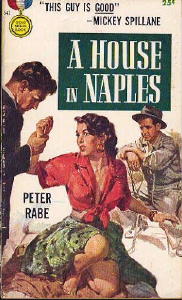 A House in Naples is one of your best books. How did you decide to write a book about the Italian black market? I don’t know how that came about actually, because the way a book starts for me is with the fascination of [a] particular mood, the fascination with the particular situation a person finds himself in, or the curiosity about how a man handles a situation of a particular sort. Then in order to make that concrete and to give it a situational and personal garb, I will pick up on anything that happens to be along. As far as the Italian setting is concerned, I had at the time poignant memories of when I had lived there. I simply used that because it was something that warmed me, but that is not how the book originated. Had I, at the time, been thinking about Maine, I might have put the whole situation in Maine. In 1956, you wrote the first of five Daniel Port novels. One unique aspect of these books is that they don’t read like the typical series. The books have a nonseries feel to them. When you created Port, were you intending to create a series character? I intended to write a series, but I didn’t intend to write Daniel Port as a series. I picked up on that being “the series,” simply because it came along at that time. In other words, it was an arbitrary decision – it didn’t grow out of my considerations of the character or of the themes I was pursuing then. It wasn’t conceived of as a series. I simply decided at one point that I’d use this as a series character. In It’s My Funeral, Port goes to Hollywood. It’s a very entertaining book, filled with fine touches of humor. Was it as fun a book to write as it is to read? I found that book oddly difficult, but that had nothing to do with the book. Instead, it had to do with the fact that I was physically not well at the time. So I couldn’t give you a good answer. It would be entirely contaminated by the physical circumstance I found myself [in]. I had the fascination for the theme. A fleeting one, it wasn’t a particularly deep one. But I was so preoccupied with my own difficulties at the time that I can’t really give you a great answer to the question you asked. The Port novel I liked much better was the one that moves him to Mexico. I don’t know the title. The Chinese Millions, I called it or something like that.  That would have been Time Enough to Die, the last book in the series and a favorite of mine. It seemed fitting that Port would end up in Mexico, so far away from his organized-crime roots. Yes, if I would have continued the series, it would have been a turning point for him, far from his roots on one hand and with a new beginning on the other. But I didn’t continue. In 1958, you published your first non-Gold Medal thriller, The Cut of the Whip, for Ace. How did this come about? It was rejected by Gold Medal. I think it was Knox Burger. It wasn’t that bad of a book that they should have rejected it. Some of the rejections I suffered were very much a function of neglect in writing. I, by temperament, write very fast, which made it very easy to jump the line and get very sloppy. Plus, I never read, again, what I have written, in many instances, and from a professional point of view, that is unforgivable. Do you think if Carroll had lived longer you would have stayed in the writing profession? I feel very sure that I would have become a better writer, a more consequential storyteller, and may well have stayed in longer. The reason I stopped was because of a combination of things. One thing was that I became very ill at the time with no prospect of recovery, which turned out to be wrong, but what that set up was some very deep disturbances. Out of those disturbances emerged a man who no longer felt like writing that sort of thing. Not to mention, at that particular time, the market changed radically, that was the end of the fifties and the beginning of the sixties, and from my point of view, it changed in such an arbitrary way that I simply couldn’t adjust myself to the change. Just before that time, you sold your one and only hardcover thriller, Anatomy of a Killer. That was rejected by Gold Medal and Abelard Schuman got the book after Gold Medal rejected it. And then two years later, a paperback firm called Universal published His Neighbor’s Wife. Was that too rejected by Gold Medal? Oh, no, that I never submitted to Gold Medal. I wrote that as an absolute quickie, a quickie with pornographic overtones. This was when I was very short of money and simply had to knock something out. Have you ever written under a pen name? Yes, I have. Is it anything that you’d like to mention? No, absolute crap. It falls in the period that we’ve been discussing, the early sixties when I was quite incapacitated, very much in need of money, and needing it quickly. So then everything just deteriorated as far as the craft was concerned. I simply made an attempt to meet the demands of a quick market. Soon after that, you took a break from writing and then you created your second series character, Manny DeWitt. Why did you venture into spy fiction? I just thought it was fun. I think it was sort of a curiosity to deal with. I have no particular feeling for spy fiction, like a man like Le Carre who deals with the subject in considerable depth, or Deighton. I very much like his work. I just picked it as another area in which to frolic. Kind of a lark. That’s what the stories were like-light, entertaining, and not too serious. Yes, but what really makes them fall short from my point of view is that they are sort of arched, and I don’t really care for that kind of story. Arched? Prettified, a very self-conscious humor. 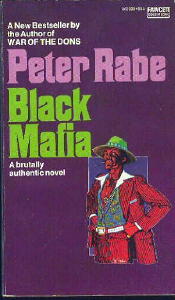 Moving on to the final stage in your writing career, you returned to organized crime as a topic, and from this, two books came out, War of the Dons and Black Mafia. How did these two books come about? I made an attempt to recapture a certain momentum that used to carry me in the past. My preoccupation with gangland settings was because they were rather meaningful to me in the past. I simply went back to them with the feeling that that would be easier than attempting something else. Most settings are simply designed by the writer, to sharpen, to accentuate, and, in some instances, to exaggerate the confrontive feelings and problems which we go through under even the mild crisis which most of us experience. This is why they were chosen, and also the gangland settings provide more leeway because there are less legal and psychological restrictions on the characters’ actions. Because of this, they were not only inviting, but easier to write than, let’s say, a good psychological novel which has to be much more tenuous in its treatment of things. So, at any rate, I went back to it mainly for reasons of familiarity. Also, in the case of War of the Dons, I picked the setting because I was fascinated by a particular gangland family in New York, which in the book I called the Gallo brothers. And in the case of Black Mafia, the setting was chosen because blacks as a theme in this adventure-type fiction were very much in the foreground. Roundtree was doing the Shaft movies, for example. So it was entirely opportunistic. Any real interest in a black confronting our culture and then taking the violent recourse of entering organized crime was only secondary as a motivation, unfortunately. Do you find antiheroes much easier to write than heroes? Yes, very much so. The hero or the way I conceive the hero is very much a stereotype. Because ofthis, I find it a technical difficulty to write about the winner, the hero. I simply can’t get in touch with the human being who is being that way. When my focus is the antihero, I find I have much more of a feel, an intro in the reality of that kind of person’s world or life. Even in the simplified and exaggerated version that they sometimes take in the kind of fiction we are talking about. So it is literally an inability to conceive of or to experience the hero type which has kept me from addressing myself to him in the fiction I have written. Whereas the antihero is much more a psychological reality for me. This determines its use and not any particular philosophical or moral theme. Has your work in psychology influenced your fiction? No, not in the least. But I think the kind of interest and focus that got me into psychology is the same one that got me into writing the way I wrote. I don’t think that they are casually related, that one produced the other. They both come from the same kind of orientation and interest. Looking back on your career, of all the books you have written, which is your favorite? I don’t know. I tend to be critical of myself in regards to things that I wrote in such haste, that I loathe to say, “This is best,” since I see so many things I wish I had done differently. I think the Fell book, Kill the Boss Goodbye, is certainly one of my favorites and the one that came out in hardcover, Anatomy of a Killer, was another, and another one I also liked was The Box. So I’d say those three were the ones I liked best.  What about in terms of the
covers? Were there any you fancied? What about in terms of the
covers? Were there any you fancied?No, I don’t even want to think about that. Of course, the covers went together with the titles. As I said, they had a contractual right to do what they wanted. By the way, you asked about editors and I just want to mention an editor who was really working very closely with me, was very good to me, and helped me develop my craft as a fellow who I only remember by his first name, Hal. I think he was probably one of the best young editors in New York at that time. When was that? When I first started, around 1954. How does it feel to be back in print again with Black Lizard Books? I find it flattering. It’s nice to be remembered through those republications. Frankly, I would have never expected them to be reprinted because I don’t feel quite as convinced about them as the publisher is. Well, you can’t be objective about your own work. If I can’t be objective about my own work, it would be nice if my lack of objectivity went in the direction of thinking that I was the cat’s whiskers [laughter]. Still, you’ve got some well-known fans in the mystery field, Donald Westlake, for example. Yes, Westlake, my God, he’s written such good things, and the reason why I take Westlake seriously in his praise is because he can be highly critical as well and is so. I received something in the mail just recently called Murder off the Rack: Critical Studies of Ten Paperback Masters, would you believe, and published by Scarecrow Press. In there, Westlake has written a critical essay entitled, “Peter Rabe.” Now that is an excellent piece of work because he not only says what he likes and doesn’t like, but he goes into the anatomy of his likes and dislikes in such a manner as to produce a thorough piece of literary criticism. You must look at it if you get the chance. Did you ever have much luck selling the rights to any of your works to movies or television? No, no luck. I signed contracts in that regard, but nothing ever came of them. The television work I did had nothing to do with my novels. I have written some things for the original Batman series. I’ve written outlines for other things, but I wasn’t very successful. Was it from this work that you got the job of writing the novelization for the movie, TOBRUK? No, they were totally separate. I got the Batman job because I knew the chief writer, Lorenzo Semple, and I got the Tobruk job because my agent found that they needed somebody to do a novelization. At that point, my writing career was already on the skids or you wouldn’t have found me doing novelizations of movie scripts. On the other hand, I found it a challenging piece of work to put the script into the form of a novel, an unexpected trial. The way the story jumps from one thing to another in the visual medium would leave enormous holes once it’s put in print. The job took a great deal of writing that wasn’t in the script. The script barely provided the skeleton of what you ended up with, which was a total surprise to me. So on that basis, as an exercise in the craft, I liked doing it, even though it wasn’t my own story. You plan to do any more writing in the future? I have been writing, but I haven’t been writing for publication. I don’t know entirely why, but partly because I’m chicken, partly because I’m writing things that are quite different from what I used to write so I have no confidence that there would be an audience for it, and the main reason I haven’t attempted to publish is because most of the things I have written are short stories and you know what the market for that is – zilch, especially in that they’re not external-action oriented. I have moved from the story carved from the situational, the external, to the story where the action is more internal, psychological. That being the emphasis and the format being the short story, you don’t really look for publication. Once I’ve enough and I have cleaned some of them, I might put them together and see if somebody would like to put them out. 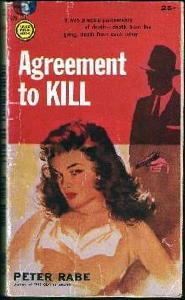 You started your career when you
were living in Maine. When did you move to the West Coast? You started your career when you
were living in Maine. When did you move to the West Coast?In the early sixties. I originally came here in order to get a slice of the pie in the television industry, which, of course, I didn’t do very well [in]. Then you lived in Italy for a while. Yes, in the late fifties. Your books reflect many of the places you have lived – for example, the Cleveland, Ohio, setting used in Bring Me Another Corpse. I don’t know why some places I’ve lived in I’ve used and others I haven’t. In retrospect, there have been some very interesting places that I’ve been exposed to that I never utilized. I think it was a matter of chance. I don’t think there was any particular pattern to the setting used. I don’t think I used Spain, for example, which was very important to me, and I liked being there at the time. When did you live in Spain? In the early sixties. Before I came to California. And I lived in southern Germany sometime during the fifties. I never used that setting as far as I remember. I think Germany was mentioned in one of your books. Yes, one of the early ones, A Shroud for Jesso. There I used some settings which I remember from a town called Hanover, which was where I was raised, so that wasn’t from when I lived in southern Germany. Those settings were from childhood memories. As a matter of fact, some of the things that I described, like the landmarks, I found out no longer exist because of the war. There was a researcher at Gold Medal who checked things like that out. Speaking of foreign countries, you’ve had good luck in having your books translated. Yes. France, in particular, has been intrigued with some of the things I have written. Have you ever read the translations and if you have, how do you feel about them? Are they true to your original work? Yes, and they are surprisingly excellent. Especially the French ones. Final note: We concluded our conversation talking about foreign languages. Besides English, Peter could speak German and French. Plus, he had a working knowledge of Italian and Spanish. Italian was his favorite language, though he felt that French is the best language for expressing content. After this short discussion, I told him that I’d send him this interview to proof and also said that I might need to ask some additional questions at a later date, to round off the interview. He said that was fine, and we said goodbye. Copyright © 1991 by George Tuttle. Reprinted from The Big Book of Noir, edited by Ed Gorman, Lee Server & Martin H. Greenberg (Carroll & Graf, 1998). PETER RABE (1921-1990) - A BIBLIOGRAPHY, by
Steve Lewis
Stark House Press has
recently published six of Peter Rabe’s novels, doubled up in
three recent trade paperbacks, and a brief biography for him can be
found on their website.
Victor Berch has done some research, however, which contradicts them on
one small point. Rabe was born in Halle, Germany, November 3,
1921, as Peter Rabinowitsch, and came to the US not with his brother,
but with his father, Michael Rabinowitsch, a physician. According
to the shipping record, they sailed on the S. S. President Roosevelt,
which left Hamburg October 26, 1938
and arrived in New York on November 5, 1938.Rabe enrolled at Ohio State University and received a Ph.D. in psychology from Western Reserve in Cleveland, making him perhaps one of the earliest hard-boiled writers with a doctorate. When the market for the kind of fiction he wrote began to disappear, Rabe fell back on the degree he’d earned and began to teach psychology at California Polytechnic State University in the late 1960s. Coincidentally – this is Steve speaking – I turned down a position at the same school at very nearly the same time, 1969, deciding to come to Connecticut to teach instead. After retiring from teaching, as described by George Tuttle, Peter Rabe died in 1990. Stop This Man! Gold Medal 506, pbo, August 1955. Gold Medal 763, 2nd pr., 1958. Gold Medal k1403, 3rd pr., 1964.  Benny Muscles In. Gold Medal 520, pbo, September 1955. Stark House Press, trade pb, 2004. [Paired with Murder Me for Nickels.] A Shroud for Jesso. Gold Medal 528, pbo, October 1955. A House in Naples. Gold Medal 547, pbo, January 1956. Gold Medal k1337, 2nd pr., 1963. Stark House Press, trade pb, October 2005. [Paired with Blood on the Desert.] Kill the Boss Good-By. Gold Medal 594, pbo, August 1956. Black Lizard 39-091, pb, October 1988. Vintage Crime/Black Lizard 74069, trade pb, April 1993. Dig My Grave Deep. Gold Medal 612, pbo, October 1956. [Daniel Port] Black Lizard 39-092, pb, December 1988. The Out Is Death. Gold Medal 657, pbo, March 1957. [Daniel Port] Black Lizard 39-093, pb, December 1988. Agreement to Kill. Gold Medal 670, pbo, May 1957. Black Lizard 39-125, pb, October 1990. 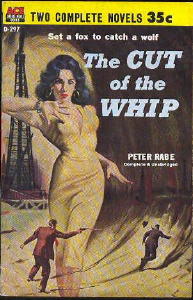 It’s My Funeral. Gold Medal
678, pbo, June 1957. [Daniel Port] It’s My Funeral. Gold Medal
678, pbo, June 1957. [Daniel Port]Gold Medal 915, 2nd pr., 1959 Black Lizard 39-127, pb, March 1990. Journey Into Terror. Gold Medal 710, pbo, October 1957. Gold Medal k1426, 2nd pr., 1964. Stark House Press 78488, trade pb, December 2003. [Paired with The Box.] The Cut of the Whip. Ace Double D-297, pbo, 1958. [Daniel Port] [Paired with Kill One, Kill Two by Robert H. Kelston.] Mission for Vengeance. Gold Medal s773, pbo, May 1958. Gold Medal 1487, 2nd pr., 1964. Blood on the Desert. Gold Medal s825, pbo, November 1958. Stark House Press, trade pb, October 2005. [Paired with A House in Naples.] Bring Me Another Corpse. Gold Medal 864, pbo, March 1959. [Daniel Port] Time Enough to Die. Gold Medal 939, pbo, November 1959. [Daniel Port] Anatomy of a Killer. Abelard-Schuman. hc, 1960. Berkley G451, pb, July 1961. 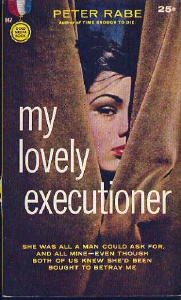 My Lovely Executioner. Gold Medal 967, pbo, February 1960. Five Star, hc, June 1999. Murder Me for Nickels. Gold Medal 996. pbo, May 1960. Stark House Press, trade pb, November 2004. [Paired with Benny Muscles In.] The Box. Gold Medal s1262, pbo, December 1962. Black Lizard 39-126, pb, August 1990. Stark House Press 78488, trade pb, December 2003. [Paired with Journey Into Terror.] Girl in a Big Brass Bed. Gold Medal k1540, pbo, 1965. [Manny DeWitt] The Spy Who Was Three Feet Tall. Gold Medal d1714, pbo, 1966. [Manny DeWitt] Code Name Gadget. Gold Medal d1830, pbo, 1967. [Manny DeWitt] War of the Dons. Gold Medal M2592, pbo, 1972. Black Mafia. Gold Medal M2939, pbo, 1974. CRIME FICTION - as by J. T. MacCARGO A Fine Day for Dying. Belmont 50823, pbo, 1975. [Novelization of Mannix television series (#2).] Round Trip to Nowhere. Belmont, pbo, 1975. [Novelization of Mannix television series (#4).] NOTE: There are two other MacCargo novels in the Mannix series by Belmont, all published in 1975, but neither was written by Peter Rabe. It is not now known who wrote the other two. All four seem to have been based on various episodes of the TV series. Follow this link for more information. One other Mannix paperback, written by Michael Avallone, was published by Popular Library in 1968. 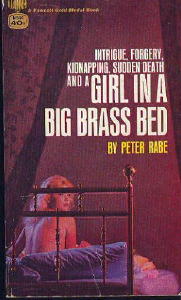 OTHER FICTION OTHER FICTIONHis Neighbor’s Wife. Beacon B542F, pbo, 1962. Tobruk. Bantam S3335, pbo, February 1967. [Novelization of movie.] OTHER FICTION - as by MARCO MALAPONTE Her High School Lover. Beacon B615F, 1963. New Man in the House. Beacon B639F, pbo, 1963. Beacon 979, 2nd pr., NON-FICTION From Here to Maternity. Vanguard, hc, 1955. [Described as being a humorous story about the birth of the author’s first son.] YOUR COMMENTS ARE WELCOME. |